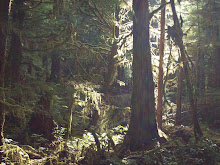Here on the north-east Olympic Peninsula, we have been spared most significant damages to our regional trees and shrubs from 'The Longest Storm', as it has been dubbed by KIRO 7 News.
First we were blessed (unless you have rear-wheel drive vehicles) with a 2-6 inch blanket of snow which served as a cozy warm comforter for our smaller plants.
While this did do some damage to tree limbs, particularly red alders and older Douglas firs which tend to produce overly long, horizontal limbs, the effects were minimal.
The gravest danger occured after the snow melt when the ground was extremely saturated. Tree roots lose their ability to 'grip' the soil when they are so lubricated by water, and even a moderate wind event (35-45mph winds) can cause a lot of catastrophic tree failures. By this I mean the entire tree topples over.
The most dangerous trees are those compromised by decay or root loss, and especially newly created 'edge' trees. These occur around new developments which are carved out of existing stands of tall trees. These trees have never had the opportunity to develop resistance to high winds, having grown up in a sheltered environment, and are very susceptible to failure.
Remember that our strongest winds typically come from a southerly direction. If you look at previously fallen trees, generally 80% or more have fallen pointing in a northerly direction.
While this doesn't absolve other wind gusts of all danger; westerlies and northerlies have, on rarer occasions, have caused significant damage, generally because trees have not built up resistance to winds from this direction.
As our soils dry out this week, the liklihood of total tree failure will lessen.
Also on the bright side, buds are swelling and one year old wood is showing color. This means the Indian Plum blooms and the light at the end of our winter tunnel is in sight.
Sunday, January 11, 2009
Friday, January 2, 2009
A Brief Introduction
Welcome to the North-West Tree Stewards initial posting.
This is intended to be a forum for both tree professionals and assorted tree nuts to share information and ask questions regarding trees.
I am an International Society of Arboriculture (ISA) certified arborist. I have been involved in the Green industry as a landscaper, nursery manager and owner, and grower of trees and shrubs for the past twenty years.
I currently spend the majority of my time consulting for homeowners, homeowner associations, developers, and city and county government in western Washington state.
While I don't have answers for every question, I probably know the person who does have that answer.
Though I have given several small seminars and talks on arboricultural subjects, they are limited to a few dozen people at most. I hope this Blog will serve as a more efficient method of connecting people to the solutions they seek.
Richard Hefley
ISA #PN-0784A
This is intended to be a forum for both tree professionals and assorted tree nuts to share information and ask questions regarding trees.
I am an International Society of Arboriculture (ISA) certified arborist. I have been involved in the Green industry as a landscaper, nursery manager and owner, and grower of trees and shrubs for the past twenty years.
I currently spend the majority of my time consulting for homeowners, homeowner associations, developers, and city and county government in western Washington state.
While I don't have answers for every question, I probably know the person who does have that answer.
Though I have given several small seminars and talks on arboricultural subjects, they are limited to a few dozen people at most. I hope this Blog will serve as a more efficient method of connecting people to the solutions they seek.
Richard Hefley
ISA #PN-0784A
Subscribe to:
Posts (Atom)
